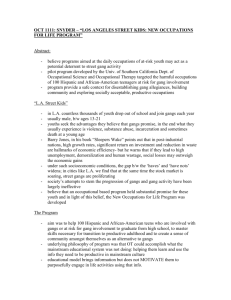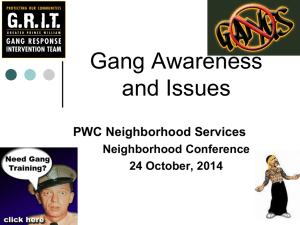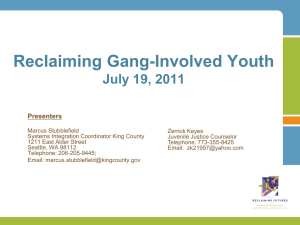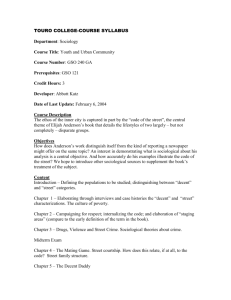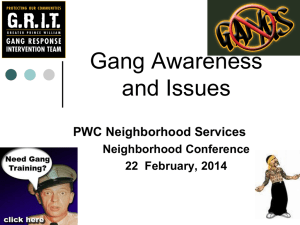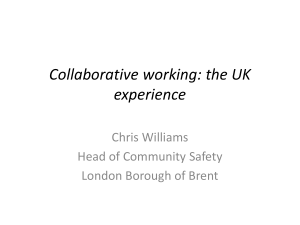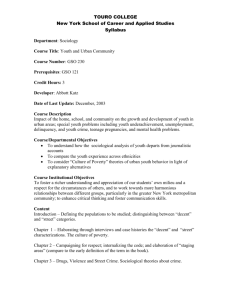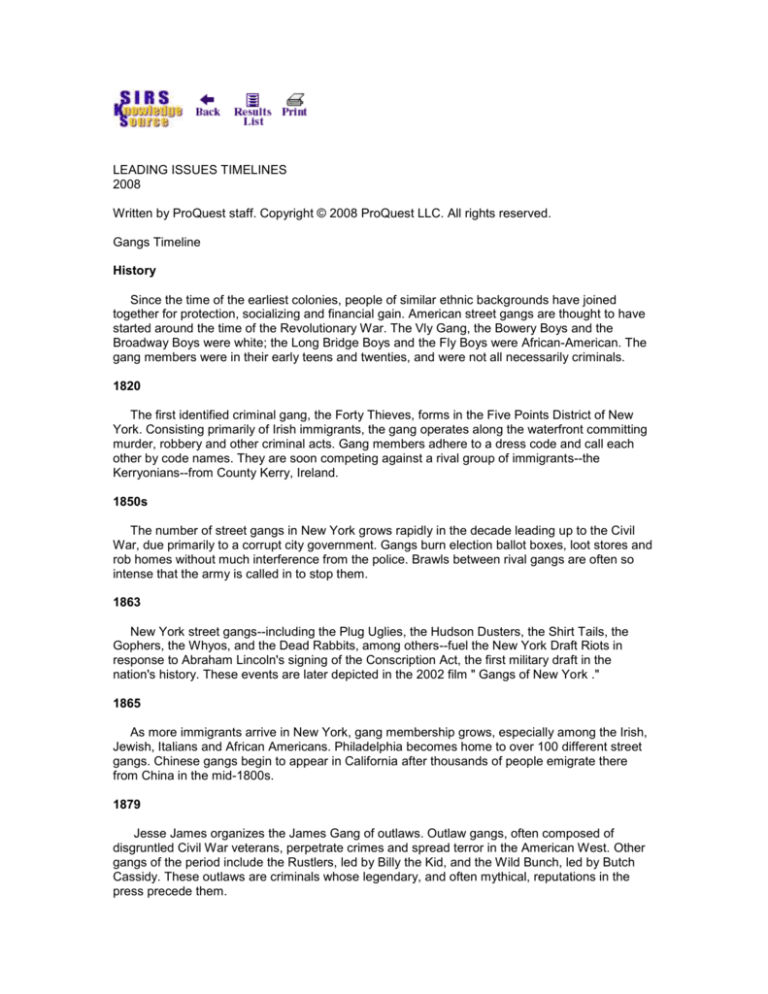
LEADING ISSUES TIMELINES
2008
Written by ProQuest staff. Copyright © 2008 ProQuest LLC. All rights reserved.
Gangs Timeline
History
Since the time of the earliest colonies, people of similar ethnic backgrounds have joined
together for protection, socializing and financial gain. American street gangs are thought to have
started around the time of the Revolutionary War. The Vly Gang, the Bowery Boys and the
Broadway Boys were white; the Long Bridge Boys and the Fly Boys were African-American. The
gang members were in their early teens and twenties, and were not all necessarily criminals.
1820
The first identified criminal gang, the Forty Thieves, forms in the Five Points District of New
York. Consisting primarily of Irish immigrants, the gang operates along the waterfront committing
murder, robbery and other criminal acts. Gang members adhere to a dress code and call each
other by code names. They are soon competing against a rival group of immigrants--the
Kerryonians--from County Kerry, Ireland.
1850s
The number of street gangs in New York grows rapidly in the decade leading up to the Civil
War, due primarily to a corrupt city government. Gangs burn election ballot boxes, loot stores and
rob homes without much interference from the police. Brawls between rival gangs are often so
intense that the army is called in to stop them.
1863
New York street gangs--including the Plug Uglies, the Hudson Dusters, the Shirt Tails, the
Gophers, the Whyos, and the Dead Rabbits, among others--fuel the New York Draft Riots in
response to Abraham Lincoln's signing of the Conscription Act, the first military draft in the
nation's history. These events are later depicted in the 2002 film " Gangs of New York ."
1865
As more immigrants arrive in New York, gang membership grows, especially among the Irish,
Jewish, Italians and African Americans. Philadelphia becomes home to over 100 different street
gangs. Chinese gangs begin to appear in California after thousands of people emigrate there
from China in the mid-1800s.
1879
Jesse James organizes the James Gang of outlaws. Outlaw gangs, often composed of
disgruntled Civil War veterans, perpetrate crimes and spread terror in the American West. Other
gangs of the period include the Rustlers, led by Billy the Kid, and the Wild Bunch, led by Butch
Cassidy. These outlaws are criminals whose legendary, and often mythical, reputations in the
press precede them.
1904
New York City becomes a breeding ground for gangs of impoverished immigrant youth living
in overcrowded tenement slums . In 1904, war breaks out between the Jewish Eastman Gang
and the Five Points Gang, with Five Points gaining control of the city. The notorious Five Points
Gang, led by Italian immigrant Paolo Antonini Vaccarelli, transforms into a national crime
syndicate and trains future mobsters Al Capone and Charles "Lucky" Luciano.
1920s
Al Capone takes over the Chicago gang operation from John Torrio, who was shot and
subsequently moved to Italy. Organized crime syndicates flourish after the 1919 ratification of the
18th Amendment to the U.S. Constitution establishes Prohibition and makes the manufacture,
sale and possession of intoxicating liquors illegal. Gangs provide a means of alcohol consumption
to the public with speakeasies and are involved in racketeering and prostitution. Most gangsters
of this time period are Irish, Jewish or Italian immigrants who are notorious for their flamboyant
style and contempt for authority.
1929
Feb. 14: Al Capone orchestrates the St. Valentine's Day Massacre , the most notorious gang
slaying of the 20th century, in the Lincoln Park neighborhood of Chicago, virtually wiping out a
rival gang.
1943
African- and Mexican-American youth adopt the jazz cultural attire of zoot suits. Tension
between Mexican-American boys and military men on leave in Los Angeles during World War II
escalates into a street fight and subsequently sparks more than a week of conflict in June 1943
known as the Zoot Suit Riots . During World War II, people of color replace white men in their
jobs while they are serving in the armed forces. When the men return, many minorities are
displaced from their jobs. Mexican-American youth form gangs called Pachucos.
1948
Hell's Angels, a motorcycle gang, forms in California. Biker gangs are viewed as a segment of
the counterculture glorified by movies such as 1957's The Wild One and 1969's Easy Rider .
Some bike gang members are involved in prostitution, extortion and drug trafficking.
1950s
Following an influx of Puerto Rican immigrants to New York after World War II, and a
migration of African Americans to northern cities, Puerto Rican and African-American gangs
become more predominant. Gang fighting increases in cities like New York, Chicago, Boston,
Philadelphia, Detroit, Cleveland and Los Angeles. Gang members are usually in their teens and
are mostly involved in small-time crime, usually fighting over girls or turf. Girl gangs begin to form
at this time.
1957
Juvenile crime is considered a great social problem. FBI Director J. Edgar Hoover states in
1957, "Gang-style ferocity--once the evil domain of hardened adult criminals--now centers chiefly
in cliques of teen-age brigands. Their individual and gang exploits rival the savagery of the
veteran desperadoes of bygone days." White gangs diminish and African-American and Hispanic
gangs increase.
1960s
The white supremacist gang Aryan Brotherhood emerges in the 1960s at California's San
Quentin Prison. The influence of this violent gang spreads to prisons throughout the U.S. An
offshoot of the Aryan Brotherhood, the Nazi Low Riders, serves as its foot soldiers on the outside
for criminal activities including drug dealing and identity theft. Following a reclassification of the
Low Riders in 2000 as a prison-based gang, its members are sent to solitary confinement as
soon as they are imprisoned. Aryan Brotherhood allies with Public Enemy No. 1 in 2005.
1965
Aug. 11-16: The Watts district in Los Angeles, California, is ablaze in rioting. The riots are an
expression of the frustration of African Americans in a struggle over civil rights. During this period,
disenfranchised minority groups form gangs in the inner cities of major metropolitan areas. The
youth culture's embrace of marijuana, heroin, LSD and other illegal drugs provides a market for
drug trafficking. Gangs that emerge from this era include the Crips and Bloods in Los Angeles ,
Devil's Disciples, Black Gangsters and Black P Stone Nation in Chicago and the Savage Skulls
and La Familia in New York. Three Chicago Black gangs participate in social change and form a
coalition called "Lords, Stones, Disciples" to work toward providing jobs and services to the Black
community.
1970s-Early 1980s
National drug networks expand, gangs form national alliances, and movies like Colors and
Scarface glorify the gangster lifestyle. Vietnamese gangs begin to form in the late 1970s, followed
by Laotian and Cambodian gangs in the early 1980s.
Late 1980s-Early 1990s
Drug networks are in full swing as street gangs develop into drug gangs. Major U.S. cities
struggle to cope with the increasing violence associated with gangs like the Latin Kings, Bloods,
Crips and Gangster Disciples, who spread their influence across the nation.
1992
• Haitian gangs surface in South Florida months after Haitian President Jean-Bertrand Aristide
is overthrown and a large-scale exodus of boat people arrives in the U.S. from Haiti.
• The city of Chicago, Illinois, passes the Gang Congregation Ordinance in an effort to combat
gang violence in the city. The anti-loitering ordinance allows Chicago police to order suspected
gang members and anyone with them to disperse if they are congregating for "no apparent
purpose." Those who refuse will be arrested.
1996
Crime rates decrease, but gangs continue to operate and recruit new members. Even young
children are used to spot police or make drug sales on street corners. As gang members are
incarcerated , jail time is seen by members as a badge of honor. Violence continues in ganginfiltrated neighborhoods where innocent bystanders are caught in the middle of drive-by
shootings . Controversy surrounds the popularity of gangsta rap because of its glorification of
violence, influence on clothing styles and introduction of terms such as "home girl" and "gang
banger" into the mainstream. Art imitates life when two prominent rappers, Tupac Shakur and the
Notorious B.I.G, are killed in gang-related murders in September 1996 and March 1997.
1999
• The U.S. Supreme Court strikes down the Chicago anti-loitering ordinance in Chicago v.
Morales , ruling that the law is unconstitutionally vague. Chicago police had arrested more than
42,000 people who refused orders to disperse in the three years the law was in effect (19921995). Chicago officials claim gang-related homicides dropped 26 percent in 1995.
• The U.S. Department of Justice's Office of Juvenile Justice and Delinquency Prevention
estimates that 47% of gang members are Hispanic, 31% are African American, 13% are white,
and 7% are Asian.
2004
According to the National Youth Gang Survey, some 760,000 gang members and 24,000
gangs are active in more than 2,900 U.S. jurisdictions in 2004, representing all 50 states and all
cities with a population over 250,000.
2006
• Prominent gangs such as the Crips and Bloods continue to operate with an increasing
number of female recruits. Mara Salvatrucha (MS-13), a Latin American gang, sets up violent
operations near the U.S.-Mexico border and across the country. In 2006, The National Drug
Intelligence Center reports that gang influence is spreading to rural and suburban areas and that
"the increased availability of methamphetamine in the Northeast, Southeast, and Great Lakes
Regions of the country is at least in part attributable to the proliferation of California- and Texasbased Hispanic gangs such as Latin Kings and Mara Salvatrucha in these areas."
• Attorney General Alberto R. Gonzales launches the Department of Justice's initiative to
combat gang violence, under its Project Safe Neighborhoods initiative . The strategy is twofold:
first, prioritize prevention programs to provide America's youth and offenders returning to the
community with opportunities that help them resist gang involvement; second, ensure robust
enforcement policies when gang-related violence does occur.
2007
Law enforcement officials warn of the growing influence of the white supremacist gang Public
Enemy No. 1. The gang, which traces its roots to the punk rock subculture in Long Beach,
California, in the 1980s, uses its wealth and recruiting power to attract new members across the
West.
2008
• Street gangs have a growing presence in the United States Armed Forces .
• The National Football League (NFL) hires experts to watch its game tapes and determine if
players are flashing gang symbols .
• An increasing number of cities nationwide use injunctions to keep gang members from
gathering and to suppress gang violence. These injunctions, issued by a judge to specific gang
members, forbid the gang members from engaging in certain activities such as wearing gang
apparel and flashing gang signs.
Compiled by Christie Riegelhaupt and Kathryn Starzyk
Accessed on 12/08/2008 from SIRS Researcher via SIRS Knowledge
Source <http://www.sirs.com>
Educators' Resources | Privacy | Accessibility | License | Contact
Copyright © 2008 ProQuest LLC. All rights reserved.


